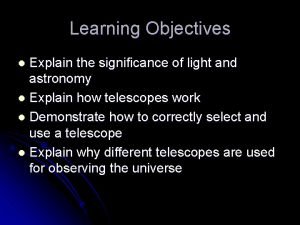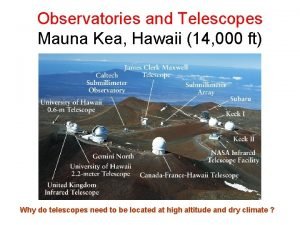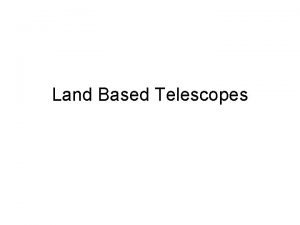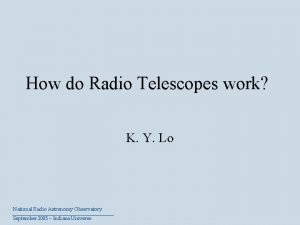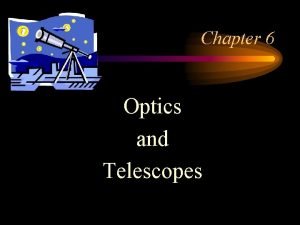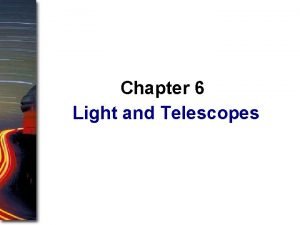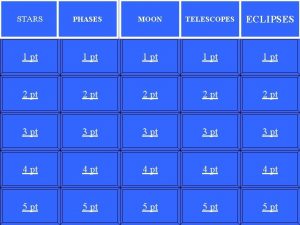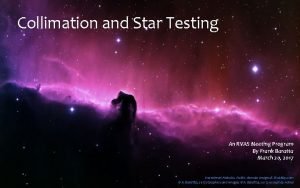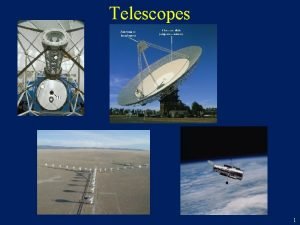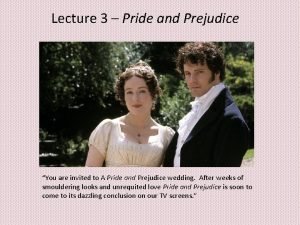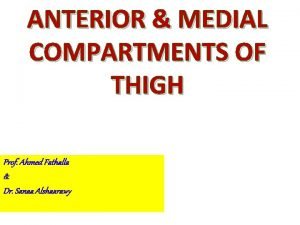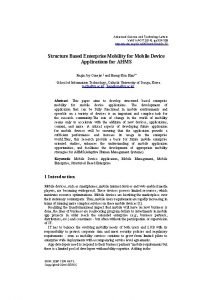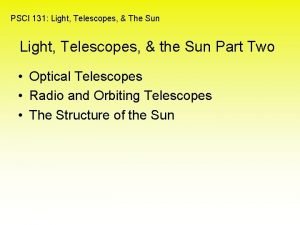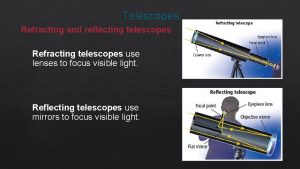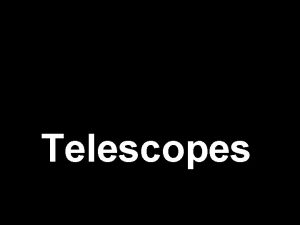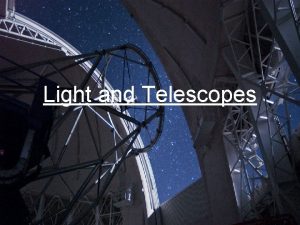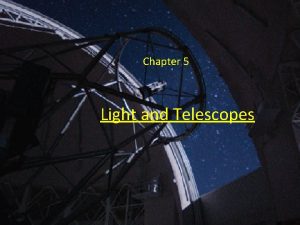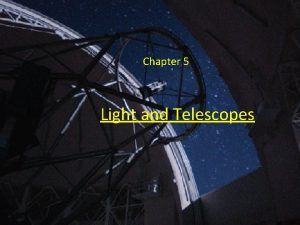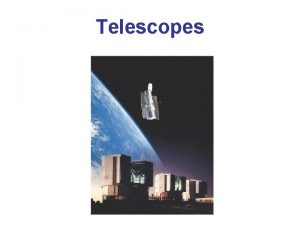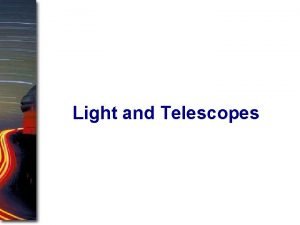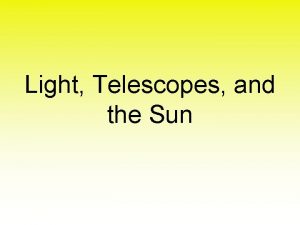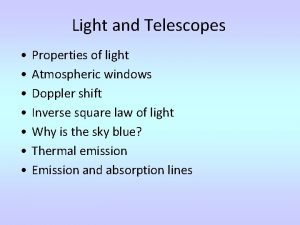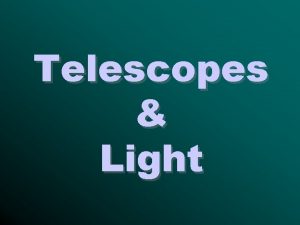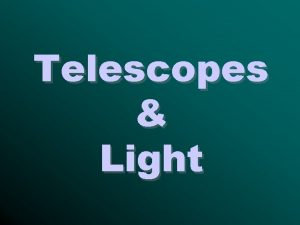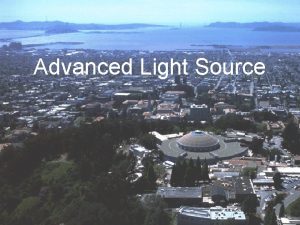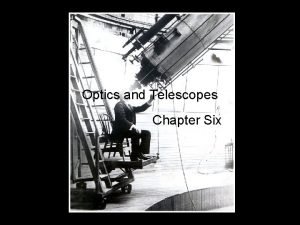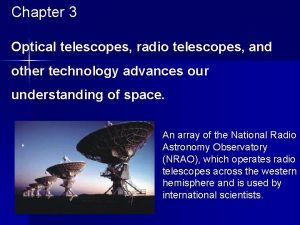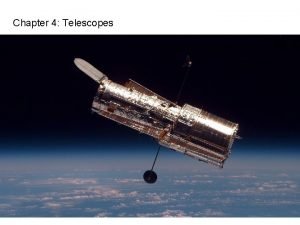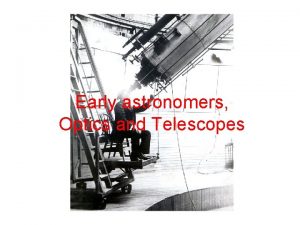Lecture 7 Light and Telescopes II Advanced Telescopes














































- Slides: 46

Lecture 7 Light and Telescopes II Advanced Telescopes

Announcements l Details about the May Term Observational Astronomy course. l Mc. M May Term runs May 14 to June 1 l l Class meets 5 days a week, 9 – 11: 55 am Prerequisite is college algebra (and this course) Travel costs will probably run about $600, depending on the number of students. Observing trip to Arizona expected to be the middle week, subject to telescope scheduling. l Side trips planned for The Grand Canyon and Beringar Crater (aka Meteor Crater).

Review - What Is A Telescope? l Telescope – An instrument for collecting and focusing electromagnetic radiation (light).

Review - What Are Telescopes For? l l l MYTH: The main function of a telescope is to magnify a distant object. THIS MYTH IS FALSE! The main function of a telescope is to make the image of a distant object brighter and sharper!

Traditional Telescopes The 4 -m Mayall Telescope at Kitt Peak National Observatory (Arizona)

Advances in Modern Telescope Design Modern computer technology has made possible significant advances in telescope design: 1. Lighter mirrors with lighter support structures, to be controlled dynamically by computers Floppy mirror Segmented mirror 2. Simpler, stronger mountings to be controlled by computers

Segmented Mirror Telescope l l Mirror segments fit together like a puzzle. Computers align the mirror segments Keck I & II Telescopes are each 10 meters Hobby-Eberly Telescope at Mc. Donald Observatory in Texas is a 9. 2 meter segmented mirror design

Examples of Modern Telescope Design of the Large Binocular Telescope (LBT) The Keck I telescope mirror

Examples of Modern Telescope Design The Very Large Telescope (VLT) 8. 1 -m mirror of the Gemini Telescopes

Interferometry Recall: Resolving power of a telescope depends on diameter D: amin = 1. 22 l/D. This holds true even if not the entire surface is filled out. • Combine the signals from several smaller telescopes to simulate one big mirror Interferometry

Keck Interferometer

Instruments On The Telescope Imaging devices l Photometer l Spectrograph l

Imaging Devices l l l Drawing what was seen through the telescope Photography greatly increased the "light gathering power" of the telescope by allowing an image to build up on the film. Electronic (digital) cameras utilizing CCD (charge-coupled device) chips have taken the place of film in many applications in the last few years.

CCD Imaging • More sensitive than CCD = Charge-coupled device photographic plates • Data can be read directly into computer memory, allowing easy electronic manipulations Negative image to enhance contrasts False-color image to visualize brightness contours

Photometer l l l Measures the intensity of the light from a celestial object very accurately Often used to monitor variable stars Data can be read directly into a computer for analysis

Photometry Projects l l Variable stars Novas & supernovas Eclipsing binaries Eclipsing planets

The Spectrograph Using a prism (or a grating), light can be split up into different wavelengths (colors!) to produce a spectrum. Spectral lines in a spectrum tell us about the chemical composition and other properties of the observed object

Daily Quiz 9 – Question 1 In which device do astronomers take advantage of chromatic aberration? A. B. C. D. The primary mirrors of reflecting telescopes. The primary lenses of refracting telescopes. The prism. The photometer.

Radio Telescopes l l The other major type of ground based telescope. Four parts: l l The Dish – collects and focuses radio signals from space. The Antenna – absorbs the radio energy and sends it through a cable to the amplifier. The Amplifier – artificially makes the radio signal stronger. Computer – actually digitally records the signal for later analysis.

Radio Astronomy l l l Radio waves from space are produced by a variety of sources. Many related to magnetic fields, or very interesting astronomical objects (e. g. black holes). Radio waves are not absorbed by dust in space, so we can see “through” dust clouds that block optical telescopes.

Radio Astronomy Recall: Radio waves of l ~ 1 cm – 1 m also penetrate the Earth’s atmosphere and can be observed from the ground.

The Largest Radio Telescopes The 100 -m Green Bank Telescope in Green Bank, WVa. The 300 -m telescope in Arecibo, Puerto Rico

Radio Interferometry Just as for optical telescopes, the resolving power of a radio telescope is amin = 1. 22 l/D. For radio telescopes, this is a big problem: Radio waves are much longer than visible light Use interferometry to improve resolution!

Radio Interferometry l l Radio signals are digitally combined by computers to produce a “virtual” radio telescope with a dish as large as the distance between the telescopes in the network. Lets us produce virtual radio telescopes with enough resolving power to read a newspaper on the moon (if it was a “radio newspaper”).

Radio Interferometry The Very Large Array (VLA): 27 dishes are combined to simulate a large dish of 36 km in diameter. Even larger arrays consist of dishes spread out over the entire U. S. (VLBA = Very Long Baseline Array) or even the whole Earth (VLBI = Very Long Baseline Interferometry)!

Daily Quiz 9 – Question 2 Radio telescopes are often connected together to do interferometry. What is the primary problem overcome by radio interferometry? A. B. C. D. Poor light gathering power. Poor resolving power. Poor magnifying power. The low energy of radio photons.

Science of Radio Astronomy Radio astronomy reveals several features, not visible at other wavelengths: • Neutral hydrogen clouds (which don’t emit any visible light), containing ~ 90 % of all the atoms in the Universe. • Molecules (often located in dense clouds, where visible light is completely absorbed). • Radio waves penetrate gas and dust clouds, so we can observe regions from which visible light is heavily absorbed.

Infrared Astronomy Most infrared radiation is absorbed in the lower atmosphere. However, from high mountain tops or highflying air planes, some infrared radiation can still be observed. NASA infrared telescope on Mauna Kea, Hawaii

Space Astronomy Able to observe at all wavelengths of the electromagnetic spectrum l Increased resolving power because of almost perfect "seeing" in space l Increased light gathering power because of the extremely black background in space l Observe almost continuously l

Space Astronomy

NASA’s Space Infrared Telescope Facility (SPITZER TELESCOPE) Warm objects glow in infrared, so IR telescopes must be cooled to very low temperatures.

Daily Quiz 9 – Question 3 Why must far infrared telescopes be cooled to a low temperature? A. B. C. D. To reduce interfering heat radiation emitted by the telescope. To protect the sensitive electronic amplifiers from overheating by sunlight. To improve their poor resolving power. To improve their poor magnifying power.


Space Infrared Astronomy l l l Here is a picture of the “freezing dust” (blue cloud) surrounding a nursery of newly-forming stars in a nearby nebula! The dust shroud is about 200ºF! The stars inside are MUCH hotter. This dust is so cold it would be invisible to optical telescopes!

Ultraviolet Astronomy • Ultraviolet radiation with l < 290 nm is completely absorbed in the ozone layer of the atmosphere. l Ultraviolet astronomy has to be done from satellites. l Several successful ultraviolet astronomy satellites: IUE, EUVE, FUSE l Ultraviolet radiation traces hot (tens of thousands of degrees), moderately ionized gas in the Universe.

Ultraviolet Astronomy l l This picture of the Andromeda Galaxy shows where all of the most recently formed stars are in the galaxy. Notice all the new stars are arranged in spiral patterns twisting out of the galaxy’s center!

X-ray Astronomy l l l Must be done from space Extremely high energy radiation (black hole accretion disks). Requires special grazing incidence telescopes

X-Ray Astronomy • X-rays are completely absorbed in the atmosphere. l X-ray astronomy has to be done from satellites. X-rays trace hot (million degrees), highly ionized gas in the Universe. NASA’s Chandra X-ray Observatory

Chandra X-ray Observatory

X-Ray Astronomy l l Many of the colored “dots” in this image are not what you think they are! They’re huge black holes! Every one of them is at the center of a distant galaxy!

Sagittarius A* Black Hole

Gamma-Ray Astronomy Gamma-rays: most energetic electromagnetic radiation; traces the most violent processes in the Universe The Compton Gamma-Ray Observatory l l Must be done from space Gamma rays can not be focused, so only detectors are used

Gamma Ray Astronomy l l l If you had gamma-ray eyes, this would be one of the brightest objects in the night sky (up to a short while ago). It’s a type of object called a quasar, and it’s actually 8 billion light years away! You’re looking at photons that are almost twice as old as the sun and the Earth!

Daily Quiz 9 – Question 4 Why are near infrared telescopes located on mountaintops and ultraviolet telescopes in Earth orbit? A. The primary infrared blocker, water vapor, is mostly in the lower atmosphere. B. The primary ultraviolet blocker, ozone, is located high in the atmosphere, far above mountaintops. C. Ultraviolet telescopes require the low temperature of space to operate. D. Both A and B.

The Hubble Space Telescope • Launched in 1990; maintained and upgraded by several space shuttle service missions throughout the 1990 s and early 2000’s • Avoids turbulence in the Earth’s atmosphere • Extends imaging and spectroscopy to (invisible) infrared and ultraviolet

For Next Time l Read Units 23 and 24 for Monday. l Remember that the Homework is due Monday as well. l Happy Valentine’s Day!
 Light light light chapter 23
Light light light chapter 23 Light light light chapter 22
Light light light chapter 22 Chapter 22
Chapter 22 01:640:244 lecture notes - lecture 15: plat, idah, farad
01:640:244 lecture notes - lecture 15: plat, idah, farad Advanced inorganic chemistry lecture notes
Advanced inorganic chemistry lecture notes Refracting telescopes exhibit great focus and color
Refracting telescopes exhibit great focus and color A building that contains one or more telescopes
A building that contains one or more telescopes Chromatic aberration affects reflector telescopes.
Chromatic aberration affects reflector telescopes. Land based telescopes
Land based telescopes Computer controlled telescopes
Computer controlled telescopes How do radio telescopes work
How do radio telescopes work Modern telescopes make it possible for astronomers
Modern telescopes make it possible for astronomers All modern large optical telescopes are refractors.
All modern large optical telescopes are refractors. The design of modern x-ray telescopes depends on
The design of modern x-ray telescopes depends on New moon telescopes
New moon telescopes Star test collimation
Star test collimation History of telescopes timeline
History of telescopes timeline Structure of radio telescope
Structure of radio telescope Put out the light, and then put out the light
Put out the light, and then put out the light Bacteria double membrane
Bacteria double membrane Bouncing off of light
Bouncing off of light Material that blocks light
Material that blocks light Electricity and magnetism lecture notes
Electricity and magnetism lecture notes Power system dynamics and stability lecture notes
Power system dynamics and stability lecture notes Microbial physiology and metabolism lecture notes
Microbial physiology and metabolism lecture notes Ternology
Ternology Parallel and distributed computing lecture notes
Parallel and distributed computing lecture notes Bilateral vs unilateral tolerance
Bilateral vs unilateral tolerance Financial institutions and markets lecture notes ppt
Financial institutions and markets lecture notes ppt Banking and finance lecture
Banking and finance lecture Extempore and lecture
Extempore and lecture Utilities and energy lectures
Utilities and energy lectures Pride and prejudice lecture
Pride and prejudice lecture Mechatronics lecture notes
Mechatronics lecture notes Embryotomy ppt
Embryotomy ppt Lecture on love courtship and marriage
Lecture on love courtship and marriage Power system dynamics and stability lecture notes
Power system dynamics and stability lecture notes Project planning and management lecture notes ppt
Project planning and management lecture notes ppt Floor of femoral triangle
Floor of femoral triangle Advanced topics in software analysis and testing
Advanced topics in software analysis and testing Advanced automotive electricity and electronics
Advanced automotive electricity and electronics Understanding standards advanced higher geography
Understanding standards advanced higher geography Advanced cities and specialized workers
Advanced cities and specialized workers Advanced science and technology letters
Advanced science and technology letters Project context
Project context Introduction to managerial accounting ppt
Introduction to managerial accounting ppt Decentralization and transfer pricing ppt
Decentralization and transfer pricing ppt





